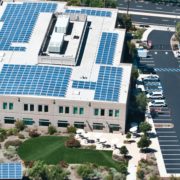The San Diego County Water Authority has earned Climate Registered gold status from The Climate Registry for verifying and publicly reporting its greenhouse gas emissions. The effort fosters transparency for the agency’s climate mitigation initiatives and will help the Water Authority track and validate emissions reductions in the future.
The Climate Registry operates North America’s largest voluntary registry for greenhouse gas (GHG) emissions. The Water Authority’s 2019 and 2020 inventories were verified and published in The Climate Registry’s public database in November, earning the agency gold status for both years.
Climate leader
“Reducing greenhouse gas emissions in the face of climate change is a critical part of our commitment to environmental stewardship,” said Water Authority Board Chair Gary Croucher. “We take our responsibility as a climate leader seriously, and we are developing forward-thinking resource solutions to ensure a sustainable environment for generations to come.”
The Water Authority works with its 24 member agencies to deliver water affordably and efficiently across San Diego County, and the agency has championed energy efficiency and environmental sustainability for decades. For instance, about half of the agency’s water is from the nation’s largest conservation-and-transfer program, and the agency is a leader in developing pumped energy storage to maximize the use of renewable wind and solar resources.
Climate Action Plan
As a centerpiece of its sustainability efforts, in 2014 the Water Authority voluntarily developed a Climate Action Plan and updates it every five years, comparing GHG emissions against a baseline and tracking progress toward State of California goals. Since the Plan’s adoption, the Water Authority has conducted annual GHG inventories and provides updates to the board of directors. Verification of the annual inventory by a third-party was another step toward validating the Water Authority’s climate mitigation efforts for stakeholders.
The Climate Registry – Climate Registered gold status
The Climate Registry is a nonprofit organization governed by U.S. states and Canadian provinces and territories. The registry designs and operates voluntary and compliance GHG reporting programs globally, and assists organizations in measuring, reporting and verifying the carbon in their operations in order to manage and reduce it. The registry also builds capacity for emissions reductions among government agencies, and spearheads innovative projects such as the Water-Energy Nexus Registry. More information is at www.theclimateregistry.org
“Organizations that become Climate Registered are the leaders in a growing movement to address climate change by managing and reducing emissions at the subnational level,” said Amy Holm, executive director of The Climate Registry. “We have just over a decade to take action that will ensure we avoid the worst effects of climate change. This kind of leadership is needed now more than ever.”



